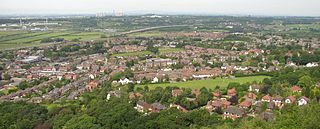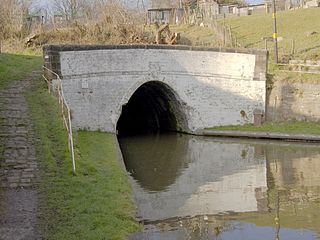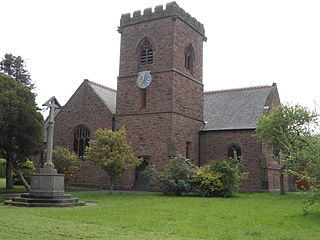
Cheshire is an ancient and ceremonial county in northwest England. It is bordered by the counties of Merseyside and Greater Manchester to the north, Derbyshire to the east, and Staffordshire and Shropshire to the south, while the western boundary consists mostly of the England–Wales border with smaller sections leading into the Irish Sea via Liverpool Bay. Cheshire's county town is the cathedral city of Chester and its most populated town is Warrington, while other towns include Congleton, Crewe, Ellesmere Port, Knutsford, Macclesfield, Nantwich, Runcorn, Widnes, Wilmslow, and Winsford. The county is split into four administrative districts: the Borough of Halton, the Borough of Warrington, Cheshire West and Chester, and Cheshire East.

Frodsham is a market town, civil parish, and electoral ward in the unitary authority of Cheshire West and Chester and the ceremonial county of Cheshire, England. Its population was 8,982 in 2001, increasing to 9,077 at the 2011 Census. It is 16 miles (26 km) south of Liverpool and 28 miles (45 km) southwest of Manchester. The River Weaver runs to its northeast and on the west it overlooks the estuary of the River Mersey. The A56 road and the Chester–Manchester railway line pass through the town, and the M56 motorway passes to the northwest.

George Herbert Leigh Mallory was an English mountaineer who took part in the first three British expeditions to Mount Everest in the early 1920s.

Northwich is a town and civil parish in the unitary authority of Cheshire West and Chester in the ceremonial county of Cheshire, England. It lies in the heart of the Cheshire Plain, at the confluence of the rivers Weaver and Dane. The town is about 18 miles (29 km) east of Chester, 15 miles (24 km) south of Warrington, and 19 miles (31 km) south of Manchester.

Middlewich is a town in the unitary authority of Cheshire East and the ceremonial county of Cheshire, England, 19.2 miles (30.9 km) east of Chester, 2.9 miles (4.7 km) east of Winsford, 5.3 miles (8.5 km) southeast of Northwich and 4.7 miles (7.6 km) northwest of Sandbach. The population at the 2011 Census was 13,595. Middlewich, with Northwich and Winsford, forms part of the Central Cheshire conurbation, with an estimated 2023 population of 130,000.

Barnton is a civil parish and village in the northwest region of England, just outside the town of Northwich, in the unitary authority of Cheshire West and Chester and the ceremonial county of Cheshire. It lies north and east of the Trent & Mersey Canal which goes through two tunnels to the west of the village.

Sir John Tomlinson Brunner, 1st Baronet, was a British chemical industrialist and Liberal Party politician. At Hutchinson's alkali works in Widnes he rose to the position of general manager. There he met Ludwig Mond, with whom he later formed a partnership to create the chemical company Brunner Mond & Co., initially making alkali by the Solvay process. As a Member of Parliament he represented Northwich, Cheshire, in 1885–1886 and then from 1887 to 1910. He was a paternalistic employer and as a politician supported Irish Home Rule, trade unions, free trade, welfare reforms and, leading up to the First World War, a more sympathetic stance towards Germany. Brunner was a prominent Freemason, and a generous benefactor to the towns in his constituency and to the University of Liverpool. He is the great grandfather of the Duchess of Kent.

Sir John Deane's Sixth Form College is a sixth form college in Northwich, Cheshire, UK. It was formerly Sir John Deane's Grammar School, which was founded in 1557.

Winsford is a town and civil parish in the unitary authority of Cheshire West and Chester and the ceremonial county of Cheshire, England, on the River Weaver south of Northwich and west of Middlewich. It grew around the salt mining industry after the river was canalised in the 18th century, allowing freight to be conveyed northwards to the Port of Runcorn on the River Mersey. The town of Winsford has an estimated population of 35,000 in 2023.

Weaver Vale is a constituency in Cheshire represented in the House of Commons of the UK Parliament since 2017 by Mike Amesbury, a member of the Labour Party.

Moulton is a civil parish and village in Cheshire, England, 3 miles (4.8 km) south of Northwich and 3 miles (4.8 km) north of Winsford.

The Lion Salt Works is the last remaining open pan salt works in Marston, near Northwich, Cheshire, England. It closed as a work in 1986 and is now preserved as a museum.

Cheshire is a county in North West England. Rock salt was laid down in this region some 220 million years ago, during the Triassic period. Seawater moved inland from an open sea, creating a chain of shallow salt marshes across what is today the Cheshire Basin. As the marshes evaporated, deep deposits of rock salt were formed.

Cheshire West and Chester is a unitary authority with borough status in the ceremonial county of Cheshire, England. It was established on 1 April 2009 as part of the 2009 local government changes, by virtue of an order under the Local Government and Public Involvement in Health Act 2007. It superseded the boroughs of Ellesmere Port and Neston, Vale Royal and the City of Chester; its council assumed the functions and responsibilities of the former Cheshire County Council within its area. The remainder of ceremonial Cheshire is composed of Cheshire East, Halton and Warrington.
This is a list of places of interest in Cheshire, England. See List of places in Cheshire for a list of settlements in the county.
The history of Northwich can be traced back to the Roman period. The area around Northwich has been exploited for its salt pans since this time. The town has been severely affected by salt mining with subsidence historically being a large issue. A programme of mine stabilisation has recently been undertaken.
Northwich is a civil parish and a town in Cheshire West and Chester, England. It contains 35 buildings that are recorded in the National Heritage List for England as designated listed buildings. Two of these are listed at Grade I, the highest grade, and the rest at the lowest grade, Grade II; none are listed at the middle grade, Grade II*. The River Dane joins the River Weaver and the Weaver Navigation within the parish. Also passing through the parish are the A533 road, the Trent and Mersey Canal, and a railway built by the Cheshire Lines Committee. Many of the listed buildings are associated with these features.

The Statue of Sir John Brunner stands outside the entrance to Mond House in Brunner Mond Works, Winnington, Cheshire, England. Sir John Brunner was an English industrialist, politician and local benefactor. He joined the alkali manufacturing company of John Hutchinson in Widnes in 1861, eventually becoming the office manager. While working there one of its chemists, Ludwig Mond decided to leave and build a factory to produce alkali by the ammonia-soda process, and Brunner joined him as a partner. The factory was built at Winnington, and in time it became the largest producer of soda in the world. Brunner then took an interest in politics, and was elected as the Liberal Member of Parliament for Northwich, holding the seat for over 30 years. The business had made him a rich man, and he was a generous benefactor in the local area. His statue was designed by Goscombe John, and was unveiled in 1922. It was moved in 1995 to stand next to the statue of Mond in front of the offices of Brunner Mond in Winnington. The statue is recorded in the National Heritage List for England as a designated Grade II listed building.
















